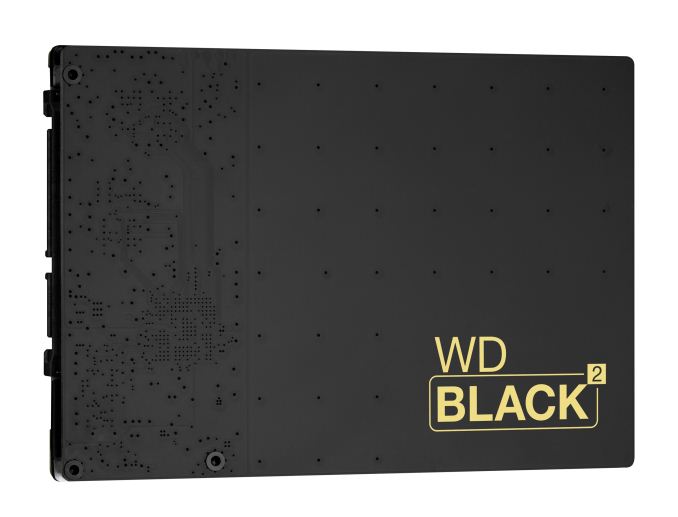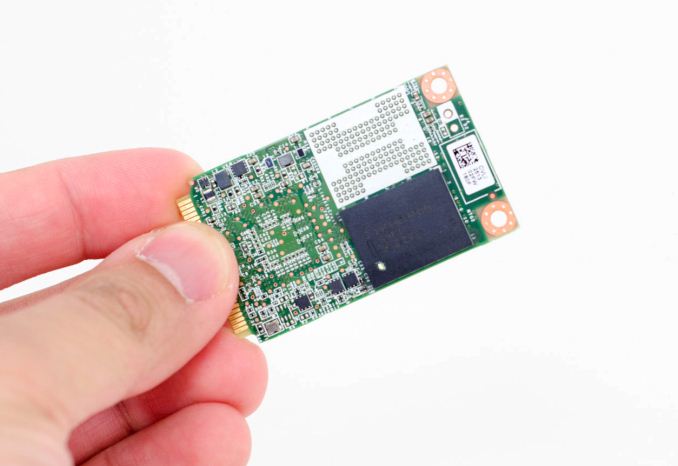The WD Black2 Review: World's First 2.5" Dual-Drive
by Kristian Vättö on January 30, 2014 7:00 AM EST
If you had asked me a few years ago, I would've said that hybrid drives will be the next big thing in the storage industry. Seagate's Momentus XT got my hopes up that there is manufacturer interest in the concept of hybrid drives and I was expecting the Momentus XT to be just the beginning with more announcements following shortly after. A hybrid drive made so much sense -- it combined the performance of an SSD with the capacity of a hard drive in an affordable and easy to use package.
Seagate's Momentus XT showed that even 4GB/8GB of NAND can make a tremendous impact on the user experience, although it couldn't compete with a standalone SSD. The reason for that was the very limited amount of NAND since the speed of an SSD relies on parallelism: a single NAND die isn't fast (though for random IO even it's still far better than a hard drive), but when you combine a dozen or more dies and read/write to them simultaneously, the performance adds up. I knew the Momentus XT was a first generation product and I accepted its limitations, but I truly expected that there would be a high-end drive with enough NAND to substitute for an SSD.
It turns out I was wrong... dead wrong. Sure Seagate doubled the NAND capacity to 8GB in the second generation Momentus XT, but other than that the hybrid drive market was pretty much non-existent. Western Digital showed their hybrid drives over a year ago but limited them to OEMs due to a unique connector. To be honest, I've not seen WD's hybrid drives used in any systems, so I'm guessing OEMs weren't the biggest fans of the connector either.
As the hard drive companies weren't able to come up with decent hybrid offerings, the PC OEMs had to look elsewhere. Intel's Ultrabook concept was a big push for SSDs because Intel required at least 20GB of flash storage or the OEM wouldn't be able to use Intel's Ultrabook branding. Of course Intel had no weapons to stop OEMs from making ultraportables without flash but given the millions Intel has spent on Ultrabook marketing, it was worthwhile for OEM's to follow Intel's guidelines. Since the PC market kind of pushed itself into a corner with the price war, it wasn't possible for PC OEMs to do what Apple did and go SSD only due to prices, but on the other hand Ultrabooks had no space for two 2.5" drives. The solution? mSATA.
mSATA is barely the size of a credit card
Unlike hard drives, SSDs didn't have to be 2.5", it was simply a matter of compatibility with existing systems. What mSATA did was allow PC OEMs to build hybrid storage systems while keeping the Ultrabook spec and form factor. In my opinion this was a huge yet missed opportunity for hard drive OEMs. All they would have needed to do was build a hybrid drive with at least 20GB of NAND in order to meet the Ultrabook spec. I bet many PC OEMs would have chosen an all-in-one hybrid drive instead of two separate drives because managing a single supplier is easier and assuming sufficient volume the pricing should have been competitive as well.
When SSDs first appeared in the consumer space, the hard drive companies didn't feel threatened. The pricing was absurd (the first generation 80GB Intel X-25M cost $595) and performance wasn't much better than what hard drives offered. Back then SSDs were only interesting to some enthusiasts and enterprises, although many were unconvinced about the long-term benefits since the technology was very new. The hard drive companies had no reason to even think about hybrid drives as traditional hard drives were selling like hot cakes.
Today the situation is very different. Let's take the 80GB Intel X-25M G1 and 240GB Intel SSD 530 as examples: the price per gigabyte has dropped from around $7.50 to $0.83. In percentage points, that's a massive 89% decrease. Drops this big are impossible to predict as they usually aren't intentional and neither was this one. The reason why NAND prices dropped so rapidly was the oversupply caused by large investments made around 2010. The sudden increase in NAND demand due to the popularity of smartphones and tablets made the NAND business look like a good investment, which is why many companies invested heavily on it. While smartphone and tablet shipments continued to increase, the thing NAND fabricators didn't take into account was that their capacities didn't (at least not very quickly). In other words, the NAND fabricators expected that the demand for NAND would continue to grow rapidly and increased their production capacities based on that but in reality the demand growth was much smaller, which lead to oversupply. Just like other goods, NAND prices are controlled by demand and supply: when there's more supply than demand, the prices have to come down for supply and demand to meet.
SSDs are no longer luxury items. Plenty of systems are already shipping with some sort of SSD storage and the number will continue to grow. The hard drive companies can no longer neglect SSDs and in fact WD, Seagate, and Toshiba have all made substantial investments regarding SSDs. Last year WD acquired STEC, Virident, and Velobit; Seagate introduced their first consumer SSD lineup, and Toshiba has been in the SSD game for years. However, there still hasn't been a product that would combine an SSD and hard drive into one compact package. The WD Black2, the world's first SSD+HD dual-drive, changes that.











100 Comments
View All Comments
Shadowmaster625 - Thursday, January 30, 2014 - link
What a joke. For $300 you can just buy a 512GB SSD and not have to deal with a 2nd partition that might just decide to disappear at any moment due to its odd driver dependency. There's actually one on sale right now for $260. What is WD smoking?LauRoman - Thursday, January 30, 2014 - link
As i understand it it is not a weird driver dependency. The driver is really only needed to flip a switch that woun't suddenly flip back by itself, even if you destroy the drive's mbr/gpt. It should work in any os after the switch is flipped. I don't know if you need a Windows install to switch it on though.Panzerknacker - Thursday, January 30, 2014 - link
Exactly, that's what I'm thinking as well, the driver is only used to flip a certain switch that's unique in this particular drive. Now that I'm thinking of it they probably did this to help with installing Windows. When installing Windows the installer will only find the 120gb partition, Windows has the strange behaviour of messing around with partitions during installation and putting system stuff on other partitions. Normally you can disconnect the other drives in the system, not on this one ofc because it's 2 in 1. Then when everything is installed you can enable the other partition with the switch triggered by the driver.I'd wonder how you would do this without Windows tho, they should also include a hardware switch.
mikato - Friday, January 31, 2014 - link
I HATE that. Detaching everything but the SSD is standard procedure during Windows installation now because of that. It's a nasty surprise when you decided to take out your hard drive or switch it with another only to find that Windows won't boot now, even when you had installed Windows on the SSD! Do you know if Windows 8 does this?HisDivineOrder - Thursday, January 30, 2014 - link
It's been a long time since WD truly impressed me with a new product.Guspaz - Thursday, January 30, 2014 - link
I've seen the 1TB Samsung 840 EVO go under $500. If you gave me the choice between paying $300 for a slow 1TB HDD with a pretty terrible 120GB SSD, or paying $500 for a fast 1TB SSD, which do you think I'd pick?About the only thing that could make the WD solution interesting is if it offered a substantially more attractive price than the SSD (and "somewhat cheaper" isn't), and if it had the SSD caching solution in hardware so that it could just be plugged in and used as a normal drive.
With a full 1TB SSD costing not much more than this thing, it's not useful for the "notebook with only one 2.5" slot" scenario... or any other scenario.
coolhund - Sunday, February 9, 2014 - link
Exactly. Also keep in mind that SSD prices keep falling and falling, while HDDs still havent gotten back to the prices that we had before that 'flood' and are not really getting cheaper nowadays. And thats why it will fail, just like the hybrid ones. I think it will actually fail even more.mobutu - Thursday, January 30, 2014 - link
Too little, Too lateI mean with very good 1TB SSDs ready to go mainstream at 400-500USD this wd2 is completely useless, especially for all the people that already use SSDs and know what a tremendous impact it has over a hdd dinosaur (performance/power/heat/silence/formfactor) (msata at 1TB already gimme a break must be a joke to look at wd2).
HDDs are close to extinct, it is a matter of time/price until they'll dissapear completely exactly like the FDD ... both are/were huge bottleneck to a system.
chizow - Thursday, January 30, 2014 - link
I thought this was pretty useless when it was announced a few months ago, but with the increasing popularity of SFF and NUC-like devices, this drive would be perfect.Gigaplex - Thursday, January 30, 2014 - link
Or you could just get a 1TB SSD, this drive isn't that much cheaper.